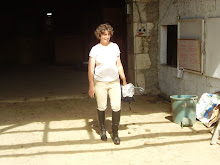*The Mighty starts with a long aerial view of Cleveland, Ohio. Eventually it zooms in on a lower middle class
neighborhood and we see Max’s grandparents in a shot that recalls the famous
painting, “American Gothic”, by Grant Wood.
Of course my students were not familiar with the painting, so I began by
showing a color photocopy to them and discussing it, asking them what they
thought about the two persons. Then we
began watching the opening shots of the film and I explained where Cleveland
was and that the river was the Ohio river.
My purpose was simply to situate where the film took place. When they saw the shot of the grandparents,
they recognized the allusion to the painting.
We hear Max’s
voice off, explaining that his grandparents looked like that “because they got
stuck with me.” At this point, I’m
pointing to the English words on the screen subtitles and translating them into
French. When I think the students can
translate a sentence, I ask them to do it and help them over the rough
spots. When there’s a word or expression
that I think is important, I draw their attention to it. For instance, if we’ve just translated, “I
never had a brain until Freak came along and loaned me his,” I’ll ask them
which word means “cerveau”. Or which
word means “jusqu’à”.
Shortly
afterwards we see Max on the bus being harassed by the Doghouse Boys gang and
their leader, Blade. The language is
quite simple to understand, so the students can “read” it with little help from
me. Then we discuss the scene and the
characters and what we learn about Max and his father. The students are free to
guess or imagine different possibilities.
I don’t validate any of them, just saying we’ll wait and see. At this point the film furnishes an excuse
for a conversation with the students, in which they have things to say and
opinions to give. Although we’ve used
French to translate the subtitles, we are now completely in English, the target
language. I help them out when they need
vocabulary and try to make everything I say 100% comprehensible, but basically
we are having a conversation in English about the scene.
One question
that comes up frequently is how much help to give to students who lack
vocabulary but want to say things. If
they ask for a word, I give it to them without any hesitation and usually write
it on the board. I remember reading a
study that showed that while students will forget 95% of a lecture they
listened to, they invariably retain the answer to their own question. So when a student formulates a request for
vocabulary, you can be fairly sure that he’ll remember your answer even if he
forgets everything else. I’d never pass on
an opportunity like that by telling him to look it up in the dictionary. If a student asks for an entire sentence, I
ask them which word they don’t know how to say.
Occasionally the class rebel will say, “All of them.” I then repeat his sentence, word by word, and
ask the class how to say each word, until we get to a word or expression that
stumps them. And I treat that word with
the same seriousness as I would any other request. After I’ve done this once or twice, students,
who don’t want to look dumber than their classmates, will limit their requests
to a single word or structure.
A book has
chapters and a film has scenes. I decide
whether I want to study a scene in depth, or simply “read” and discuss it, or,
if it is an action scene with little or no dialog, let the students watch it
with no pauses. Tomorrow I will discuss how to study a scene in more
detail. To be continued ….

No comments:
Post a Comment